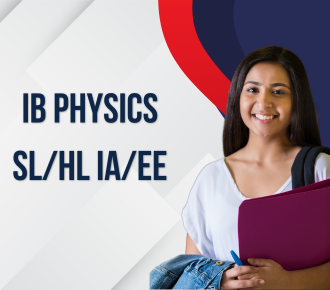- 9:30am - 6:30pm, Mon - Sun
- +91 7836034313
- R2-149 first floor M3M Cosmopolitan, sector 66 Gurugram 122102

Preparing for IB Physics SL/HL can be overwhelming, especially when balancing Internal Assessments (IA) and Extended Essays (EE) along with the final exams. This guide offers structured advice tailored for students aiming to excel. With actionable tips, priority topics, past year questions (PYQs), common mistakes, downloadable resources, and links to tutoring services, you’ll be well-equipped to succeed.
This post integrates advice based on the IB Physics, IB MYP/DP physics tips, IB MYP/DP physics notes, and the IB MYP/DP physics syllabus, making it an essential resource for both SL and HL students.
IB Physics isn’t just about memorizing equations—it’s about understanding concepts, applying formulas, and writing clear scientific explanations. Many students struggle not because the content is difficult but because they lack direction. By breaking your study into prioritized chapters, using past papers, and preparing thoroughly for IA and EE, you can approach exams with confidence.
Standard Level (SL): Covers core physics topics and applications with fewer extensions.
Higher Level (HL): Adds more in-depth topics, mathematical rigor, and extended practical assessments.
Internal Assessment (IA): A student-led practical investigation accounting for 20% of your final score.
Extended Essay (EE): A 4,000-word independent research project where you explore physics topics in depth.
Balancing conceptual learning with practical work is key to achieving top scores.
Measurements and Uncertainties
Mechanics
Thermal Physics
Waves
Electricity and Magnetism
Circular Motion and Gravitation
Atomic, Nuclear, and Particle Physics
Energy Production
Wave Phenomena
Fields
Electromagnetic Induction
Quantum and Nuclear Physics
Download the complete syllabus here.
Mechanics: Central to both SL and HL, covering forces, energy, and motion.
Electricity and Magnetism: Requires deep understanding and equation application.
Measurements and Uncertainties: Crucial for IA, lab reports, and data analysis.
Thermal Physics: Important for both exams and EE topics.
Waves
Circular motion and gravitation
Atomic physics
Particle physics
Advanced nuclear concepts (unless required for HL)
Prioritize practicing numerical problems and conceptual questions equally.
Master core formulas—learn how and when to apply them.
Practice diagrams—label forces, vectors, and fields correctly.
Work on units and significant figures consistently.
Time yourself while solving problems to simulate exam conditions.
Choose an experiment with controlled variables and measurable outcomes.
Collect ample data with repeated trials.
Use proper error analysis and uncertainty calculations.
Include clear graphs, tables, and explanatory text.
Pick a topic you are genuinely curious about.
Narrow your focus to a question that can be answered with available resources.
Structure your essay: introduction, methodology, analysis, conclusion.
Cite reputable sources and include theoretical frameworks.
Overlooking uncertainties in measurements.
Misusing formulas by skipping derivations or ignoring limitations.
Poor graphing techniques—not scaling axes or adding error bars.
Confusing vectors and scalars in numerical problems.
Neglecting the rationale in lab reports—simply stating results isn’t enough.
Choosing overly ambitious IA/EE topics that lack practical scope.
Force diagrams and equilibrium problems
Conservation of energy and momentum questions
Ohm’s law and circuit analysis
Data handling, uncertainties, and error propagation
Wave speed and reflection problems
Solve one past paper section per day.
Identify recurring question formats and focus areas.
Practice writing extended answers that explain reasoning.
Access curated PYQs and examiner reports here.
Use separate sections for theory, formulas, and numerical problems.
Include conceptual questions that challenge your understanding.
Write definitions and laws in your own words for better retention.
Practice sketching and labeling diagrams daily.
Keep a reference sheet of common waveforms, circuits, and motion graphs.
First pass: Understand concepts.
Second pass: Solve problems.
Third pass: Review errors and unclear areas.
Download sample physics notes here.
Research Question: Clear, measurable, and relevant.
Background Theory: Relate your topic to IB physics principles.
Methodology: Step-by-step procedure with controlled variables.
Data Collection: Tables, graphs, uncertainties.
Analysis: Interpretation with formulas and error discussion.
Conclusion: Summary with reflection on results and limitations.
✔ Use repeated trials
✔ Mention equipment used
✔ Justify measurement methods
✘ Avoid ambiguous results
✘ Don’t skip error bars
For one-on-one help, check our tutors.
Investigating how temperature affects electrical resistance in a wire
Measuring gravitational acceleration using pendulums
Exploring how magnetic fields influence charged particle motion
Too broad or vague
Lacking available data or experimental setup
Outside the syllabus or beyond available equipment
Start your EE journey with our free-trial resources.
| Week | Focus Area | Activities |
|---|---|---|
| 1 | Mechanics fundamentals | Solve 20 problems, revise formulas |
| 2 | Electricity circuits | Practice problems and unit conversions |
| 3 | Uncertainties and data | Work on lab reports and graphing |
| 4 | Waves and motion | Revise wave problems, diagrams |
| 5 | Past papers and PYQs | Time-based practice |
| 6 | IA/EE writing | Draft reports and essays |
Plan reviews every weekend to check progress.
Graphing apps – For plotting curves and analyzing motion.
Simulation tools – Explore wave interactions and electric circuits virtually.
Cloud notes apps – Keep formulas and diagrams organized across devices.
Online forums – Collaborate and clarify doubts in real time.
Includes:
✔ Weekly topic breakdown
✔ Practice problem tracker
✔ IA experiment planning sheet
✔ EE research checklist
✔ Formula and unit reference sheet
✔ Exam strategy reminders
✔ Graphing and data analysis templates
Download it here: IB Physics Checklist.
Don’t go through this alone. Find support through:
Tutors in Gurugram: Personalized coaching and doubt-solving.
Free Trial Sessions: Explore methods tailored to your learning style.
Pricing Plans: Affordable packages designed for SL and HL students.
Success in IB Physics SL/HL IA/EE comes from combining consistent practice with strategic planning. By focusing on priority topics, avoiding common mistakes, making proper use of past papers, and leveraging available resources like tutors and checklists, you can confidently approach both your exams and practical assessments.
Prepare smart, stay disciplined, and trust your scientific instincts—you are ready to excel.








